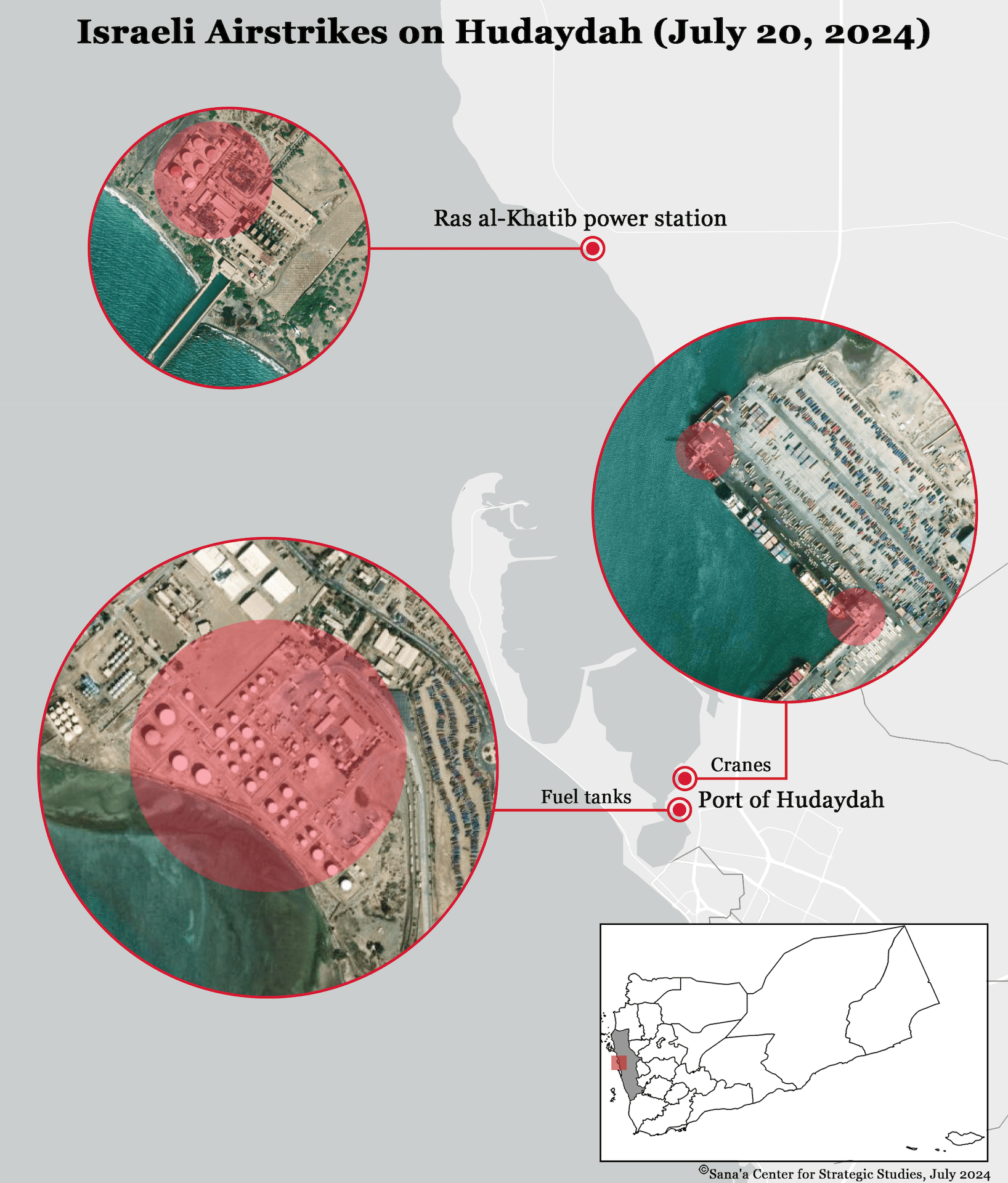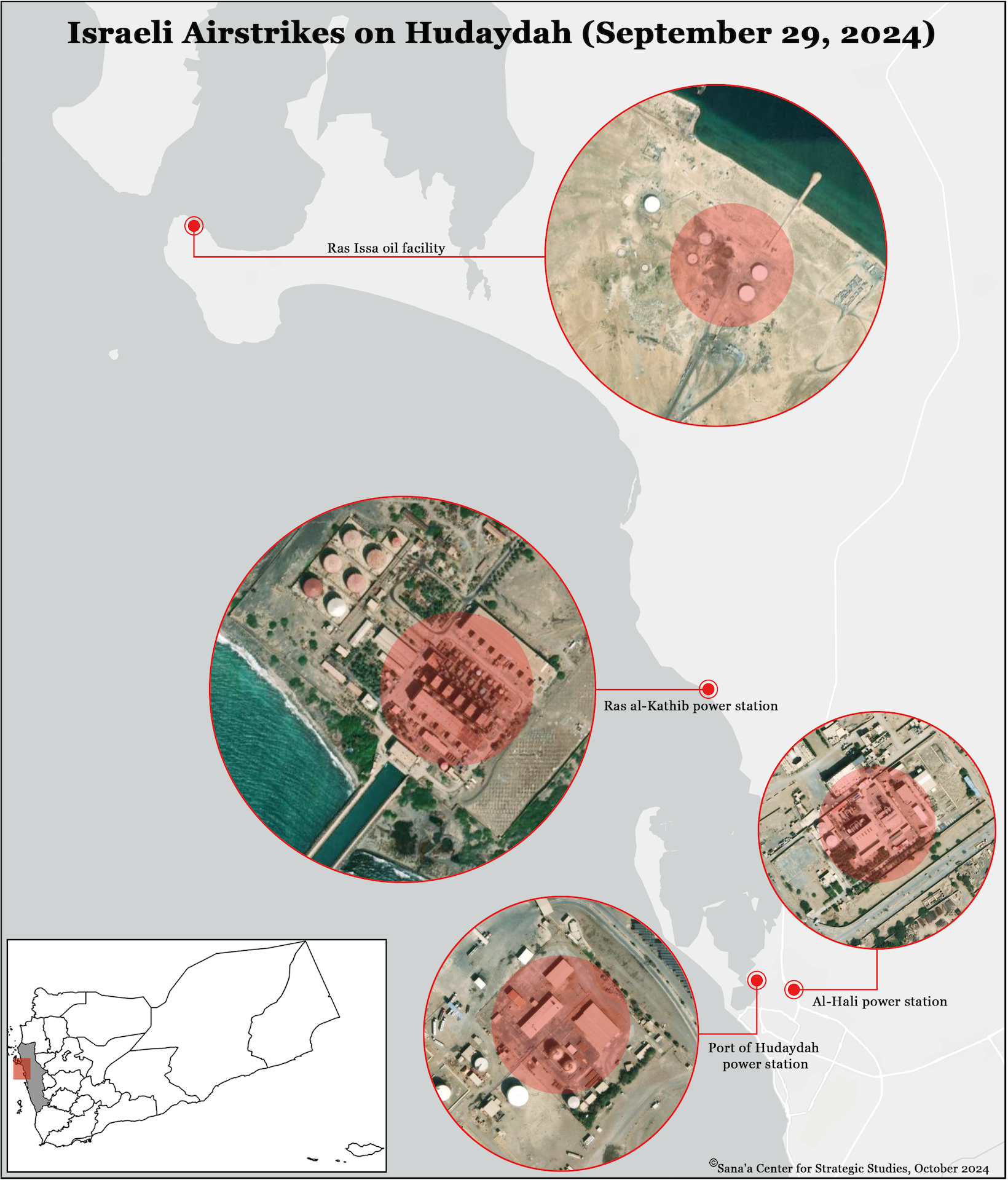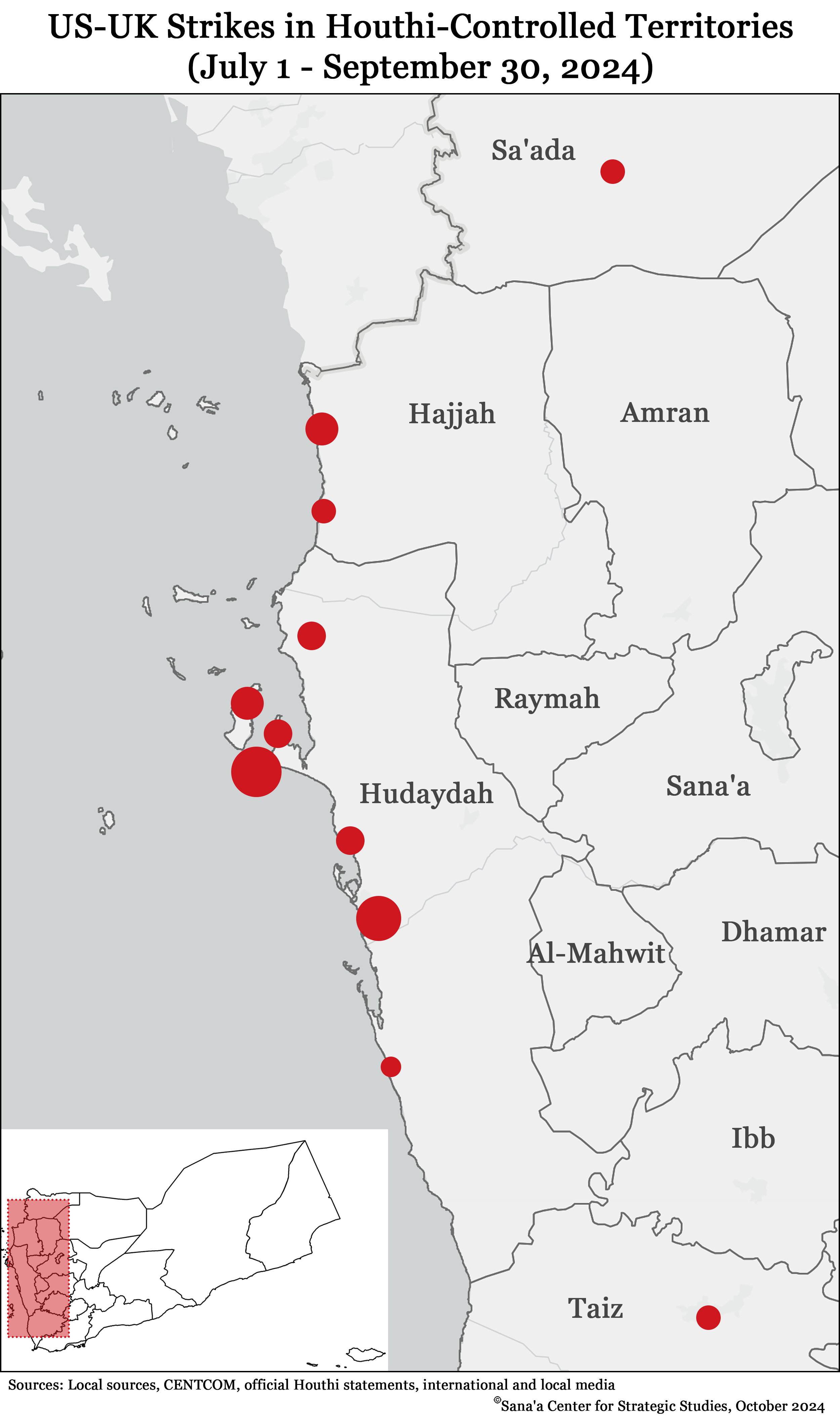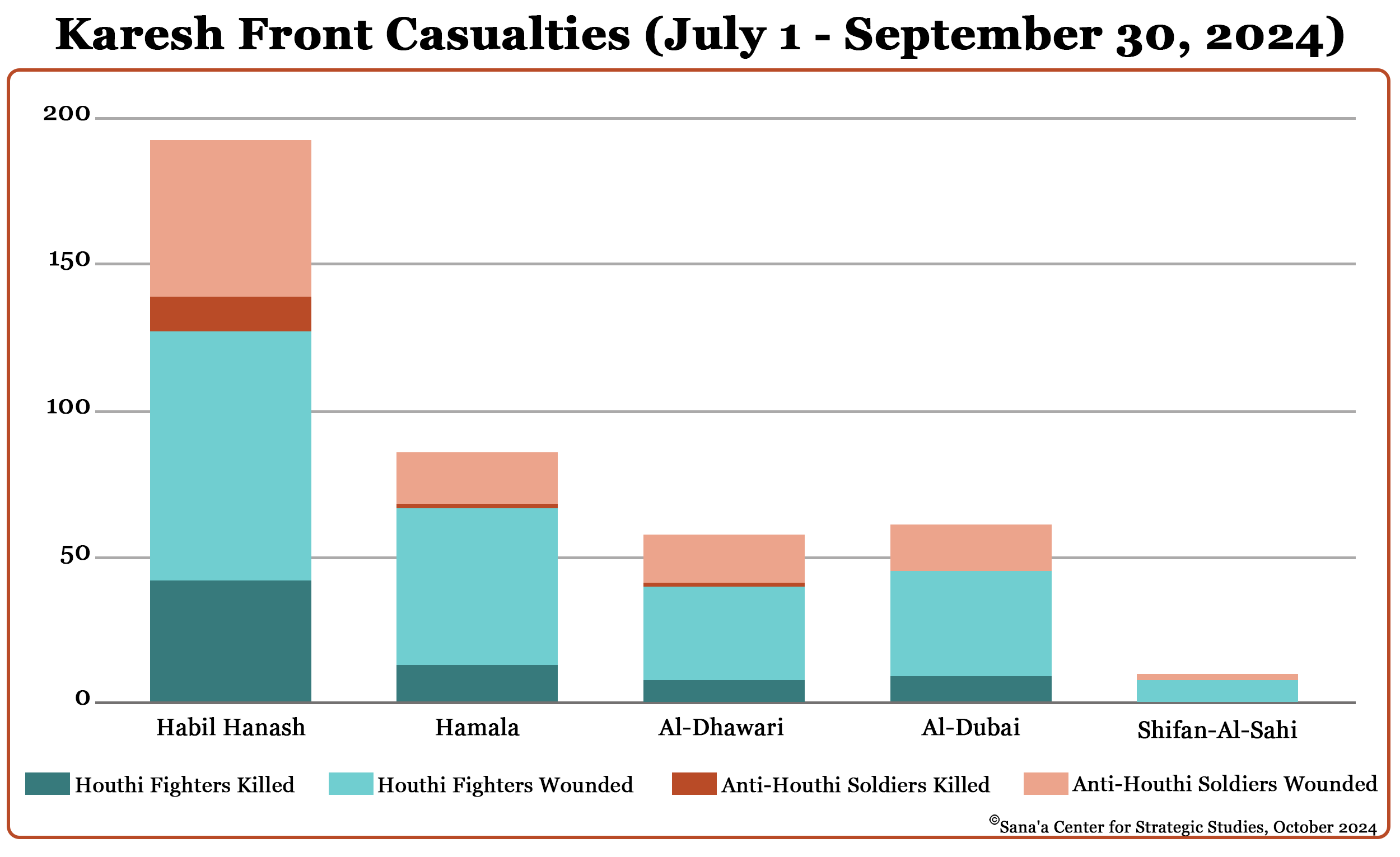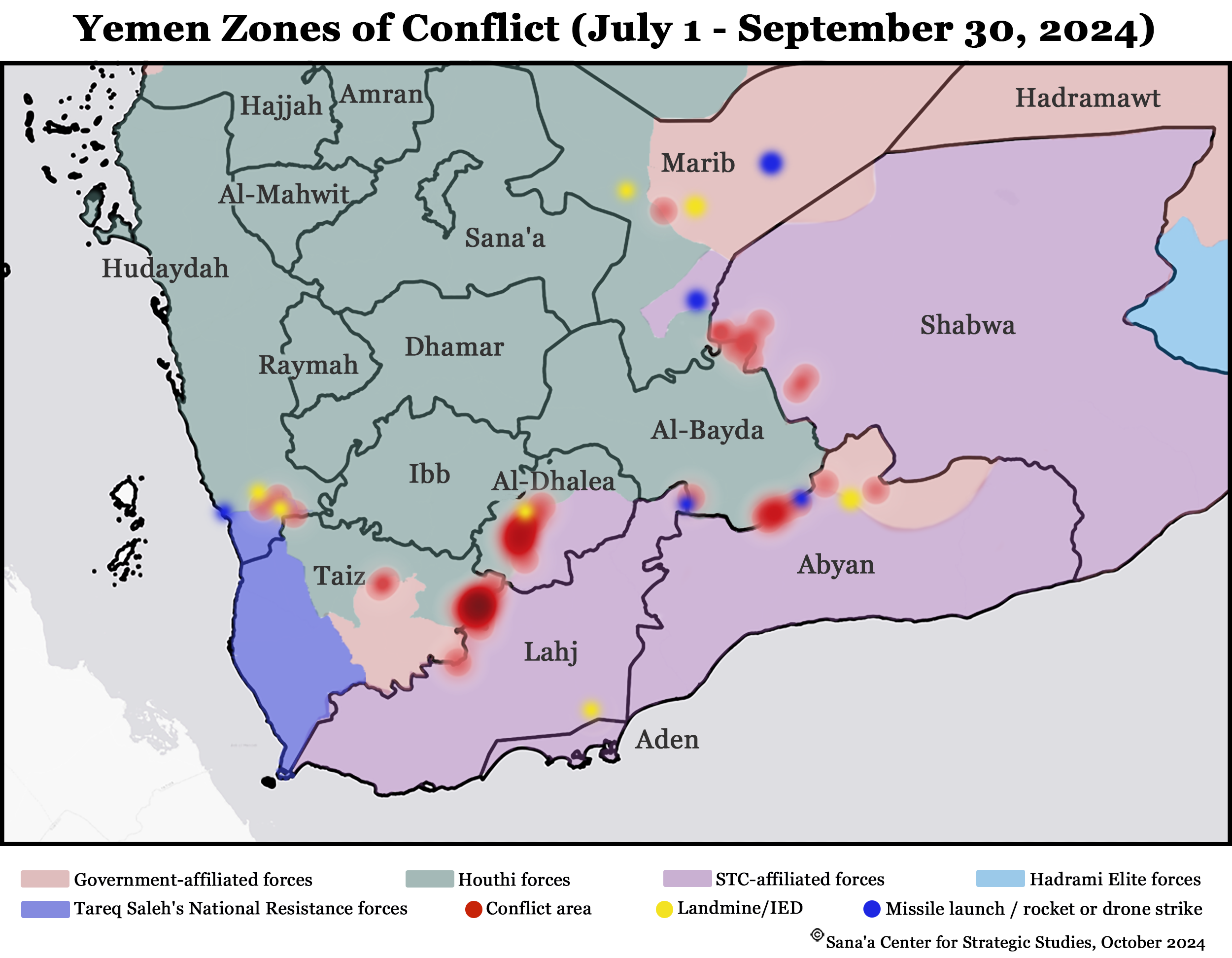Israeli Airstrikes Damage Port of Hudaydah, Not Houthi Morale
Israel struck Yemen directly for the first time during the ongoing conflict in response to a Houthi drone that crept by Israeli defense systems and detonated in Tel Aviv. The July 19 Houthi attack was the first to reach central Israel, and killed one person and wounded 10 others. But it paled in comparison to the Israeli response the following day. Dubbed Operation Outstretched Arm, the retaliation involved five simultaneous airstrikes on Houthi-controlled areas of Hudaydah, using missiles launched from F-15, F-16, and F-35 fighter jets. Strikes targeted the port of Hudaydah, and the Ras al-Kathib electricity station, located north of Hudaydah city along the coast. Six people, all Yemen Petroleum Company (YPC) port employees, were killed by the strikes, and more than 80 others were wounded, many of whom were hospitalized with severe burns.
Initial damages were significant, particularly to fuel tanks, which caused secondary explosions and fires that burned for several days. A port official estimated that damages excluding fuel were over US$20 million, while a Houthi official told the Sana’a Center that the cost of damaged port infrastructure, lost fuel, and destroyed depots would be closer to US$500 million. The port of Hudaydah also sustained significant damage, including two cranes that required immediate repairs. As such, the attack caused immediate humanitarian concern, as over 80 percent of the country’s humanitarian aid, essential goods, and fuel – upon which 28 million Yemenis depend – flows through Hudaydah. The World Food Programme reported that the attacks damaged 33 oil storage tankers and nearly 800,000 liters of WFP-owned fuel.
Despite the devastation, the Houthis tried to appear unaffected by the strikes: only four days later, the port was open and receiving shipments. Within days, the group’s leadership vowed a response, and by August 4, the Houthis had resumed attacks on commercial vessels.
On September 15, the group targeted Tel Aviv with its newly unveiled Palestine 2 missile, which broke into pieces after being intercepted over central Israel. While Israeli officials refuted Houthi claims that the Palestine 2 was hypersonic, the attack was still a new benchmark for the group: the missile traveled around 2,000 km in just over 11 minutes and was able to (at least temporarily) evade initial Israeli defense systems.
A full two weeks passed before Israel’s second counterstrike on September 29, which came as part of a larger coordinated attack on the Axis of Resistance network in Lebanon, Syria, Iraq, and Yemen following Israel’s assassination of Hezbollah leader Hassan Nasrallah in Lebanon two days earlier. As in July, the airstrikes targeted key fuel tanks and power infrastructure at the Port of Hudaydah, Ras Issa, Ras al-Kathib, and Al-Hali. But unlike their precursor, the September attacks seemed to be significantly less damaging, likely due to Houthi anticipation. Most of the fuel tanks hit in Ras Issa appear to have been more or less empty, and partial power was restored to two of the targeted electricity stations within 24 hours. The Houthi health ministry reported that at least four people were killed and 40 injured in the attacks.
Taken together, the Israeli attacks on Hudaydah’s ports were of a fundamentally different variety than the US-UK airstrikes against Houthi launch sites, which aim to limit the group’s ability to use missiles and drones in attacks against Red Sea shipping. While the US and UK have been notably careful in their general avoidance of bombing heavily populated areas and dual-use and civilian infrastructure, the Israelis are not bound by the same concerns that have tempered the West’s strategy. Rather, the Israeli strikes are a signal to Houthi leadership of the heavy price of further attacks on Tel Aviv.
In this regard, Israel seems to have shared American miscalculations about the group. Hardened by years of airstrikes from the Saudi-led coalition and willing to tolerate and even exploit civilian suffering, the Houthis are unlikely to be dissuaded by anything that does not seriously threaten the group’s leadership or its ability to hold power. Likewise, popular support for actions against Israel, ostensibly in support of Gaza and now Lebanon, reflects the success of the group’s propaganda efforts in recent years. And with the power vacuum in the wake of Nasrallah’s death, Houthi leader Abdelmalek al-Houthi may feel now is the time to pick up the mantle as the leader of the Iran-led Axis of Resistance. Recent Houthi launches in the aftermath of the September 29 strikes should be a signal to all invested parties that the Houthis will not give up.
Yemen may be spared the Israeli scorched earth campaigns witnessed in Gaza and now Lebanon simply by the limitations of the Houthi’s current arsenal, but the group’s missile and drone capabilities are constantly improving. Should the Houthis acquire the capability to inflict significant or repeated damage in Israel, all bets are off.
Houthi Attacks Halve, US Funnels More Money into Red Sea Defense
October marked 10 consecutive months of air raids inside Yemen, with US strikes reportedly targeting and destroying a total of 141 Houthi weapons systems in the last three months. CENTCOM transcripts documenting the strikes on X continue to tick out the same laundry list of targets they have for nearly a year – weapons parts, launch pads, and the occasional downing of an unmanned aerial vehicle (UAV) – in an effort to combat Houthi attacks against commercial shipping in the Red Sea.
Alongside US backing of Israel and initiatives to counter other Axis of Resistance powers, these strikes and US maritime patrols have left the American public with a hefty bill. A recent report found that US taxpayers have spent an estimated US$22.76 billion related to the war in Gaza, which included military aid to Israel (US$17.9 billion) and US$4.86 billion for US Navy operations in the Red Sea – a high price for a policy that a US general said earlier this summer was “failing.”
The strikes have left Yemeni leaders unimpressed as well. In a September interview with The Guardian, PLC deputy and STC chief Aiderous al-Zubaidi told journalists that “the airstrikes, instead of deterring the Houthis, are having the opposite effect … [they are] making them stronger.”
To this end, the Houthis are still working hard to appear unbothered but seem to be slowing the pace of their operations against commercial shipping. Twelve ships were confirmed as targeted in the last three months, just over half of the 21 ships targeted by the group last quarter. Vessel profiles and ownership data, as in previous months, have varied. Since May, the Houthis claimed that any ship owned by a company using Israeli ports would be fair game, but many attacks seem incongruent with this narrative.
The major Red Sea incident of import was the near-sinking of the Sounion. The Greek-owned Suezmax tanker was carrying nearly 1 million barrels of Iraqi crude when Houthi forces struck it on August 21. The dramatic event, which involved Houthi militants boarding the vessel after it was abandoned and planting additional explosives for propaganda purposes, appeared to threaten an environmental disaster for several weeks. However, this was avoided with EU-led efforts to tow the ship to a “safe area” after the Houthi group refused to take responsibility for the vessel.
As the Houthi maritime threat persists, the Pentagon continues to fund operations in the Red Sea.On October 3, Bloomberg reported that the US is planning to spend US$1.2 billion related to its deployment in the Red Sea. Among the proposed spending items are a number of missile types, laser-guided rockets, drone interceptors, and maintenance on ships already deployed in the region. 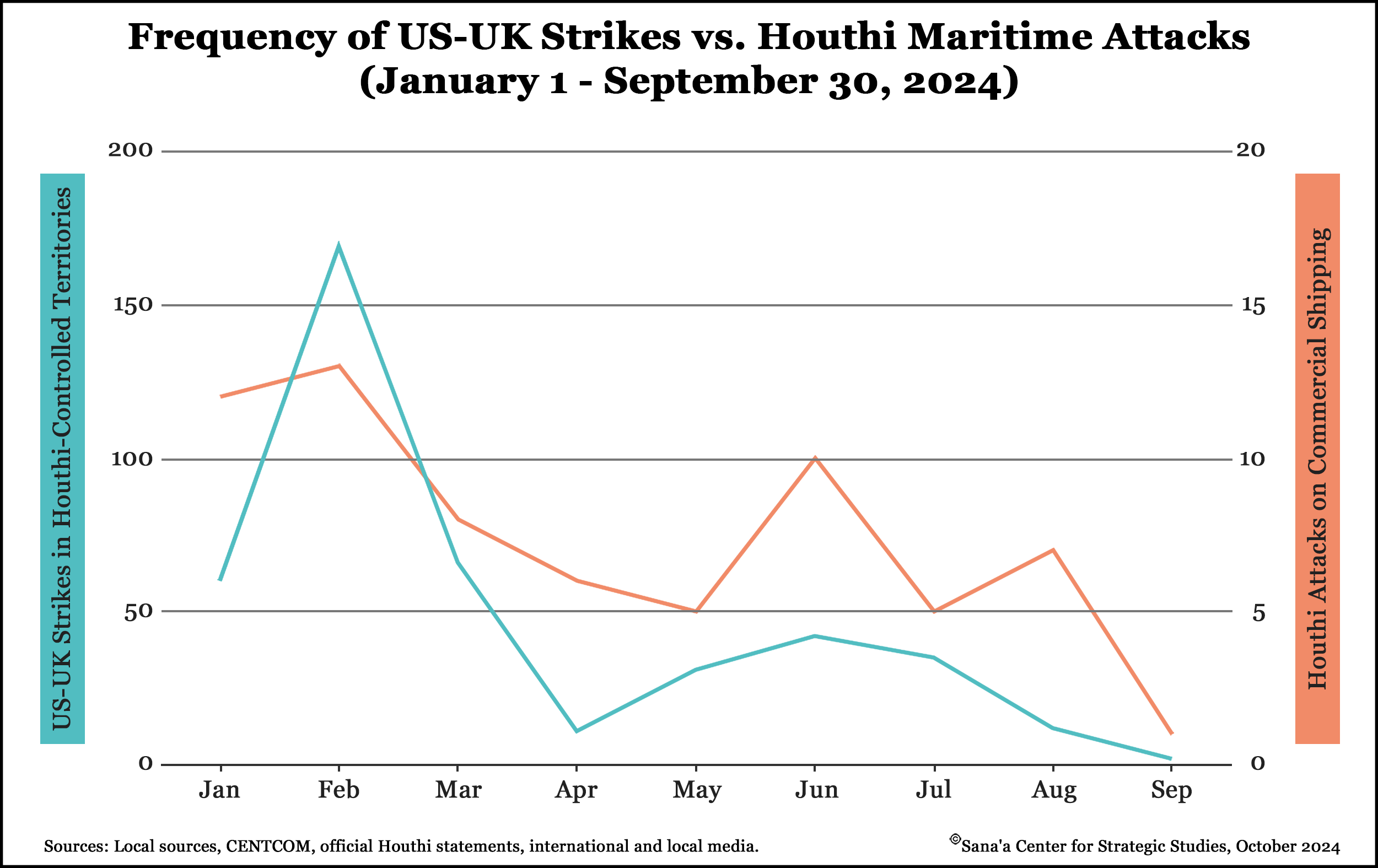
Whether this added line in budgetary expenses will come with a change in strategy remains to be seen. Regardless, any future military action will likely remain preventative in nature – the US is continuing to take a cautious approach toward any further escalation with the Houthis, including the idea of providing weapons to armed groups such as Tareq Saleh’s National Resistance forces or the Southern Transitional Council (STC) – and goading from some Yemeni parties for the US to target Houthi officials. And with Israel now more directly engaged, the US may have found an effective bad cop to its thus-far tempered strategy. 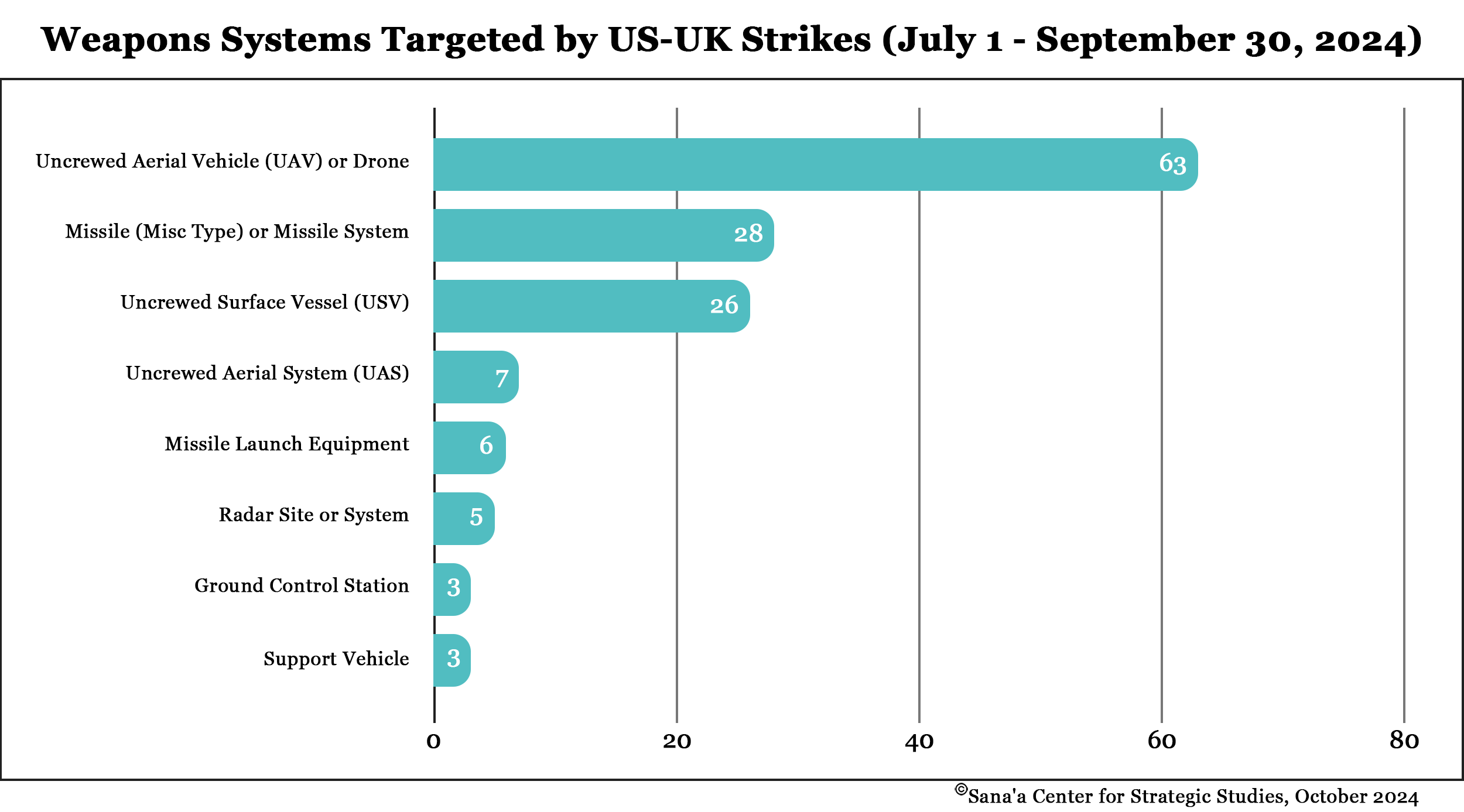
Houthis Turn to Russians as Weapons Flows in Hudaydah Continue
Suspected Houthi weapons smuggling has continued in earnest in recent months, likely to the chagrin of Western powers, whose naval missions have the appearance of permanent fixtures in Red Sea waterways. In the past three months, the Sana’a Center has recorded 19 instances of suspected smuggling along Hudaydah’s coasts, 11 of which occurred in September alone.
As with most weapons smuggling scenarios reported by local sources, these operations often involve large vessels making unscheduled visits to smaller non-civilian ports. Roads and areas around these ports are then closed, and fishermen are prevented from entering waters nearby. This quarter, boats reportedly docked at a total of 10 sites, ranging from areas along Al-Luhiyah district in the north to Al-Tuhayta district to the south. The contents of such deliveries are unknown but likely carry components for missiles, drones, and other weapons to be assembled or stored in depots far from the ports. The Sana’a Center also documented the suspected arrival of foreign military advisors to Hudaydah multiple times in recent months.
Many of the weapons shipments likely came from ports across the Red Sea – Houthi smuggling routes from Africa have long been documented, with gunrunners in Eritrea and Sudan playing a key role in the post-October 7 era. However, sophisticated weaponry such as missile parts originate from Iran before being shipped to African ports or handed off to boats in the Red Sea. American and European Red Sea patrols have obstructed some weapons flows in recent months; a source at the port of Al-Makha said a shipment of drones and missile parts from Djibouti was recently intercepted.
As the Houthis look to up their arsenal and evade maritime policing, their sourcing may expand to obtaining arms from Moscow. US efforts to block a Houthi-Russia weapons deal in July have apparently failed; Reuters recently reported that such a deal is not only ongoing but is now being brokered by Iran. If successful, it could see the handover of a number of P-800 Oniks (Yakhonts) – supersonic anti-ship cruise missiles with a higher level of accuracy than anything in the current Houthi arsenal. This rumored deal, in addition to unusual Russian activity in Houthi ports earlier this summer, likely has Washington and the EU on high alert.
Karesh Frontlines Focus of Fighting, Hudaydah Floods Force Pause
Regular frontline fighting between the Houthis and various pro-government and UAE-backed groups has continued, with frontlines shifting little in the last three months. Continuously hot areas include the border region between Taiz and Lahj (known as the “Karesh” fronts), central Al-Dhalea, areas of southern Hudaydah near the border with Taiz, and areas surrounding Marib city. 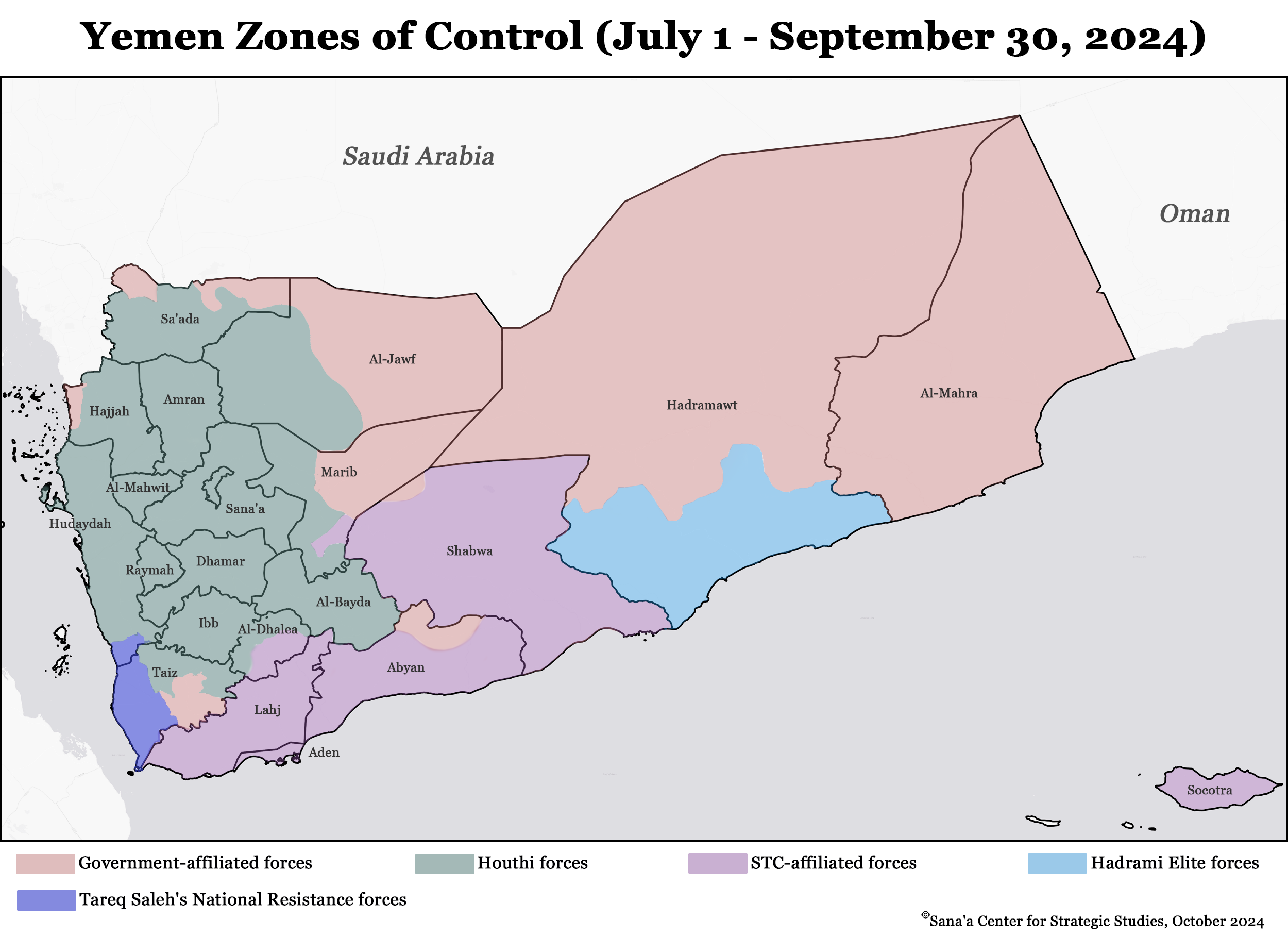
Each side continues to defend critical road junctions and high ground, with only minor changes in the zones of control. A major battle occurred after a surprise Houthi attack against STC-affiliated forces in Lahj’s Al-Musaymir district on September 6. In the raid, the Houthis captured several military positions in the mountainous region, prompting STC forces and UAE-backed Giants Brigade forces to rapidly deploy reinforcements. These forces eventually counterattacked and retook their original positions over several days of fierce fighting, in addition to seizing a Houthi site.
Fighting in Hudaydah reached a standstill in early September after heavy rains caused the warring parties to halt fighting on virtually all frontlines in the Red Sea governorate. The floods washed away defensive fortifications built by both sides and silted up Houthi tunnels used as weapons silos. Fighting is slowly resuming, with limited mortar fire in the mountainous region between Taiz’s Maqbanah district and Hudaydah’s southern Hays district, but clashes in Hudaydah will likely not resume in earnest until fortifications are restored to pre-flood levels.
In Marib, early July witnessed a Houthi attack against UAE-backed Giants Brigade forces along the border between Harib and Al-Abdiyah districts, which ended with Giants Brigade forces countering and regaining control of the strategic Mount Arish military site. Other Houthi advances that month on the Al-Rawda front in Serwah district, northwest of Marib city, and further north in Al-Raghwan district, ended with the Houthis failing to gain new ground.
Other Developments in Brief
July 25: Hadramawt Coast Guard forces were directed to withdraw from the Ras Baghshwa area in the east of Al-Dis district after weeks of protests by Al-Hamoum tribesmen. The tribesmen argued that the soldiers’ presence threatened residential and agricultural lands – calling the area “one of the last refuges” they had left. Local media reported that some activists criticized the withdrawal, arguing it would benefit smugglers and weapons traders, as the area is well-known among locals as a hotspot for smuggling contraband.
August 16: An Al-Qaeda militant detonated a car bomb at an STC-affiliated 3rd Support and the Backup Brigade military base in Abyan’s Mudiya district. The blast killed 16 soldiers and wounded 18 others. It was the first suicide attack against forces affiliated with the Operation Arrows of the East counterterror campaign in Abyan and was carried out on the second anniversary of the campaign’s launch.
August 29: STC chief and PLC member Aiderous al-Zubaidi assigned fellow PLC member and Giants Brigade commander Abdelrahman al-Muharrami, known as Abu Zaraa, to manage security and counterterrorism operations for the Southern Armed Forces – a wide coalition of STC-affiliated and UAE-backed units.
August 31: Abu Saleh and Qayfah tribesmen raided the Radaa Central Prison in Al-Bayda after news circulated that Houthi forces had falsified information about the rape of an 11-year-old boy from the Abu Saleh tribe who was visiting a detained relative the previous week. Tribesmen originally surrounded the prison on August 26 after learning that the boy had been raped, allegedly by a Houthi supervisor (mushrif). On September 14, Houthi forces executed the accused assailant in a controversial case, which some claimed was a sham cover-up for the real assailant, a Houthi official known as Abu Harb.
September 18-24: Ahead of the annual commemoration of the September 26 Republican Revolution, Houthi security forces arrested dozens of activists, journalists, and other civilians who signaled their support or plans to celebrate the event. The Houthis increasingly view the commemoration of September 26, which marks the overthrow of the Zaidi Mutawakkilite Imamate and the establishment of the Yemen Arab Republic in 1962, as competing with or repudiating their September 21, 2014, military takeover of Sana’a. The crackdown on republican celebrants this year has been particularly harsh amid ongoing Houthi mass arrest campaigns targeting alleged spies in the aid sector and civil society.

 اقرأ المحتوى باللغة العربية
اقرأ المحتوى باللغة العربية
